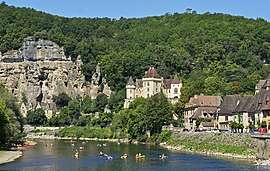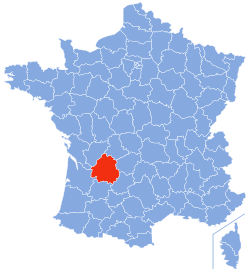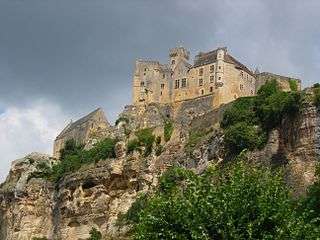Dordogne
Dordogne (UK: /dɔːrˈdɔɪn/ dor-DOYN, US: /dɔːrˈdoʊn/ dor-DOHN or /dɔːrˈdɔːnjə/ dor-DAWN-yə;[1][2] French: [dɔʁdɔɲ] (![]()
Dordogne | |
|---|---|
   From top down, left to right: prefecture building in Périgueux, Château de Castelnaud-la-Chapelle, river Lourde and La Roque-Gageac | |
 Flag  Coat of arms | |
 Location of Dordogne in France | |
| Coordinates: 45°0′N 0°40′E | |
| Country | France |
| Region | Nouvelle-Aquitaine |
| Prefecture | Périgueux |
| Subprefectures | Bergerac Nontron Sarlat-la-Canéda |
| Government | |
| • President of the General Council | Germinal Peiro (PS) |
| Area | |
| • Total | 9,060 km2 (3,500 sq mi) |
| Population (2016) | |
| • Total | 414,789 |
| • Rank | 58th |
| • Density | 46/km2 (120/sq mi) |
| Time zone | UTC+1 (CET) |
| • Summer (DST) | UTC+2 (CEST) |
| Department number | 24 |
| Arrondissements | 4 |
| Cantons | 25 |
| Communes | 505 |
| ^1 French Land Register data, which exclude estuaries, and lakes, ponds, and glaciers larger than 1 km2 | |
History
| Year | Pop. | ±% p.a. |
|---|---|---|
| 1791 | 433,343 | — |
| 1801 | 409,475 | −0.56% |
| 1806 | 424,113 | +0.70% |
| 1821 | 453,136 | +0.44% |
| 1831 | 482,750 | +0.64% |
| 1841 | 490,263 | +0.15% |
| 1851 | 505,789 | +0.31% |
| 1861 | 501,687 | −0.08% |
| 1872 | 480,141 | −0.40% |
| 1881 | 495,037 | +0.34% |
| 1891 | 478,471 | −0.34% |
| 1901 | 452,951 | −0.55% |
| 1911 | 437,432 | −0.35% |
| 1921 | 396,742 | −0.97% |
| 1931 | 383,720 | −0.33% |
| 1936 | 386,963 | +0.17% |
| 1946 | 387,643 | +0.02% |
| 1954 | 377,870 | −0.32% |
| 1962 | 375,455 | −0.08% |
| 1968 | 374,073 | −0.06% |
| 1975 | 373,179 | −0.03% |
| 1982 | 377,356 | +0.16% |
| 1990 | 386,365 | +0.30% |
| 1999 | 388,293 | +0.06% |
| 2006 | 404,052 | +0.57% |
| 2011 | 415,168 | +0.54% |
| 2016 | 414,789 | −0.02% |
| source:[3] | ||
The county of Périgord dates back to when the area was inhabited by the Gauls. It was originally home to four tribes. The name for "four tribes" in the Gaulish language was "Petrocore". The area eventually became known as the county of Le Périgord and its inhabitants became known as the Périgordins (or Périgourdins). There are four Périgords in the Dordogne.
- The "Périgord Vert" (Green Périgord), with its main town of Nontron, consists of verdant valleys in a region crossed by many rivers and streams;.
- The "Périgord Blanc" (White Périgord), situated around the department's capital of Périgueux, is a region of limestone plateaux, wide valleys, and meadows.
- The "Périgord Pourpre" (Purple Périgord) with its capital of Bergerac, is a wine region.
- The "Périgord Noir" (Black Périgord) surrounding the administrative center of Sarlat, overlooks the valleys of the Vézère and the Dordogne, where the woods of oak and pine give it its name.


The Petrocores took part in the resistance against Rome. Concentrated in a few major sites are the vestiges of the Gallo-Roman period-–the gigantic ruined tower and arenas in Périgueux (formerly Vesone), the Périgord museum's archaeological collections, villa remains in Montcaret, and the Roman tower of La Rigale Castle in Villetoureix. The earliest cluzeaux (artificial caves either above or below ground) can be found throughout the Dordogne. These subterranean refuges and lookout huts were large enough to shelter entire local populations. According to Julius Caesar, the Gauls took refuge in these caves during the resistance.
After Guienne province was transferred to the English Crown under the Plantagenets following the remarriage of Eleanor of Aquitaine in 1152, Périgord passed by right to English suzerainty. Being situated at the boundaries of influence of the monarchies of France and England, it oscillated between the two dynasties for more than three hundred years of struggle until the end of the Hundred Years' War in 1453. The county had been torn apart and, as a consequence, that modeled its physiognomy.
During the calmer periods of the late 15th and early 16th centuries, the Castillon plain on the banks of the Dordogne saw a development in urban architecture. The finest Gothic and Renaissance residences were built in Périgueux, Bergerac, and Sarlat. In the countryside, the nobility erected the majority of the more than 1200 chateaux, manors and country houses. In the second half of the 16th century, however, the terrors of war again visited the area, as the attacks, pillaging, and fires of the Wars of Religion reached a rare degree of violence in Périgord. At the time, Bergerac was one of the most powerful Huguenot strongholds, along with La Rochelle. Following these wars, Périgord, fief of Henry of Navarre, was to return to the Crown for good and would continue to suffer from the sudden political changes of the French nation, from the Revolution to the tragic hours of the Resistance.
We also encounter the memory of the region's most important literary figures: Arnaut Daniel, Bertran de Born, Michel de Montaigne, Étienne de La Boétie, Brantôme, Fenelon, Maine de Biran, Eugene Le Roy, and André Maurois; its great captains: Talleyrand, Saint-Exupery, Biron; and even entertainer and activist Josephine Baker. A number of ruins (La Chapelle-Faucher, I'Herm) have retained the memory of the tragedies that took place within their walls. Several of the castles and châteaux are open to visitors; some of them, such as Bourdeilles and Mareuil, house noteworthy collections.
In addition to its castles, chateaux, churches, bastides, and cave fortresses, the Périgord region has preserved since centuries past a number of villages that still have their market halls, dovecotes, bories (stone huts), churches, abbeys, and castles. Saint-Léon-sur-Vézère, Connezac, Saint-Jean-de-Côle, La Roque-Gageac, and many others contain important and visually interesting architectural examples. The old quarters of Périgueux or Bergerac have been restored and developed into pedestrian areas. A number of small towns, such as Brantôme, Issigeac, Eymet and Mareuil, have withstood the changes of modern times. A special mention should be made in this respect to Sarlat and its Black Périgord area.
Dordogne is one of the original 83 departments created on 4 March 1790 during the French Revolution. It was created from the former province of Périgord, the county of Périgord. Its borders continued to change over subsequent decades.
- In 1793 the communes of Boisseuilh, Coubjours, Génis, Payzac, Saint-Cyr-les-Champagnes, Saint-Mesmin, Salagnac, Savignac, Saint-Trié and Teillots were transferred from Corrèze to Dordogne.
- In 1794 Dordogne ceded Cavarc to Lot-et-Garonne. Later in 1794 (albeit during the subsequent year under the Republican Calendar in use at the time), Dordogne gained Parcoul from Charente-Inférieure.
- Following the restoration, in 1819, the commune of Bonrepos was suppressed and merged with the adjacent commune of Souillac in Lot.
In 1870, shortly after France fought against Prussia in a war that the enemy was winning, a young aristocrat called Alain de Monéys was savagely tortured and then burned by a crowd of between 300 and 800 people for two hours on 16 August in a public square in the village of Hautefaye in the north-west of the department. Details of the incident remain unclear: the leading participants appear to have been drunk, and before the introduction of mass education most of the witnesses would have been unable (and possibly unwilling) to write down what they saw. But at some stage the victim died, and following a trial four individuals identified as culpable were in turn condemned to die by guillotine. The sentence was carried out in the same public square on 13 February 1885.
It was suggested that the victim had reported the (bad) news of the war in a way that implied support for the enemy, although subsequently it became clear that his patriotic credentials were beyond reproach. It was also suggested that the mob had been antagonized when he called out, "Vive la République!" (Long live the republic) at a time when the patriotic villagers valued the imperial regime, which Parisian revolutionaries were in the process of destroying.
The incident was widely reported at the time and has since been extensively researched. This summary relies on the work of Alain Corbin,[4] a modern historian specializing in the 19th century who analysed the incident and the mass psychology behind it.
Geography
The department is part of the region of Nouvelle-Aquitaine and is surrounded by the six départements of Haute-Vienne, Corrèze, Lot, Lot-et-Garonne, Gironde, and Charente. Dordogne is the third-largest department of metropolitan France.
Politics
The President of the General Council is Germinal Peiro of the Socialist Party.
| Party | seats | |
|---|---|---|
| • | Socialist Party | 34 |
| Union for a Popular Movement | 5 | |
| • | French Communist Party | 4 |
| Miscellaneous right | 5 | |
| • | Union of Democrats and Independents | 2 |
Current National Assembly Representatives
Demographics
The population peaked at 505,789 in 1851 according to that year's census. After 150 years of steady decline it fell below 400,000 by the year 2000. This reflected the long term population decline observed in many of the rural departments resulting from changes in agriculture and the lure of higher industrial wages available in more urbanized regions. However, during the first decade of the 21st century, the decline has been reversed.
Dordogne has a thriving British immigrant community. The region counts between 5,000 and 10,000 British residents and 800 British entrepreneurs, drawn by a laid-back lifestyle, warm climate, and lower cost of living. The village of Eymet is at the heart of the trend, with 200 British families among 2,600 inhabitants.[6]
Tourism


 Canoeing on Dordogne River
Canoeing on Dordogne River

There are more than 1,500 castles in Dordogne, making it "The Other Chateau Country"[7] including:
- Beynac
- Biron
- Bourdeilles
- Castelnaud-la-Chapelle
- Commarque
- Hautefort
- Jaurias
- La Besse
- La Mothe
- La Petite Filolie
- La Renaudie
- La Roche
- La Roque
- Manoir de Mitonias
- Milandes
- Monbazillac
- Pécany
- Puymartin
The famous caves of Lascaux have been closed to the public, but a replica of Lascaux II is open to visitors and is a major tourist attraction. Périgueux has important Roman ruins, including an arena which is still visible inside a public park located near the town centre.
Dordogne is particularly popular with Britons and other foreigners, as a location for second homes.[8]
See also
In popular culture
Films
- Ridley Scott's debut film The Duellists (1977), starring Harvey Keitel and based on a Joseph Conrad story, was filmed around Sarlat-la-Canéda in the Dordogne. The movie won Best Debut Film at the 1977 Cannes Film Festival.
- The Dordogne was the setting for the film Ever After (1998), starring Drew Barrymore and Anjelica Huston.
- The film Chocolat (2000 film), directed by Lasse Hallström and starring Juliet Binoche and Johnny Depp, was shot in part in the village of Beynac-et-Cazenac, on the Dordogne River.
Literature
- Jean M. Auel's Shelters of Stone (2002) takes place in what is now Dordogne.
- Douglas Boyd, the author husband of flautist Atarah Ben-Tovim,[9] set parts of each of his six thrillers in Dordogne.[10]
- Meg Cabot's series Queen of Babble begins with part of the book set in the Dordogne region.
- Glenn Cooper's The Tenth Chamber (2010) is set and based on prehistoric cave paintings in the Vézère River Valley in the Dordogne.
- Michael Crichton's science-fiction novel Timeline (1999) is placed in two time periods of Dordogne.
- Martin Walker's first book in the Bruno Chief of Police series is titled Death in the Dordogne.
References
- "Dordogne" (US) and "Dordogne". Oxford Dictionaries UK Dictionary. Oxford University Press. Retrieved 2 September 2018.
- "Dordogne". Merriam-Webster Dictionary. Retrieved 2 September 2018.
- Site sur la Population et les Limites Administratives de la France
- Corbin Alain, Le village des "cannibales", Paris, Aubier, 1990, 204 p.
- http://www.assemblee-nationale.fr/
- Woods, Katherine (1931). The Other Chateau Country; the Feudal Land of the Dordogne. John Lane The Bodley Head.
- Dare Hall, Zoe (5 June 2019). "Why Dordogne property seduces British buyers". Financial Times.
- Ben-Tovim, Atarah. "Autobiography".
- "Books by Douglas Boyd". Amazon.com.
External links
| Wikimedia Commons has media related to Dordogne. |
| Wikivoyage has a travel guide for Dordogne. |
- Dordogne Tourist Highlights (in English)
- Dordogne France Information (in English)
- Préfecture website (in French)
- Conseil général website (in French)
- Atlaspol website. Politics of Dordogne (in French)
- Dordogne at Curlie (in English)